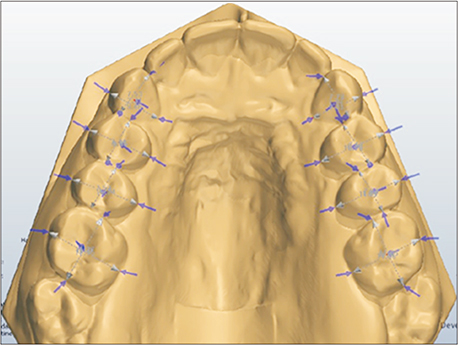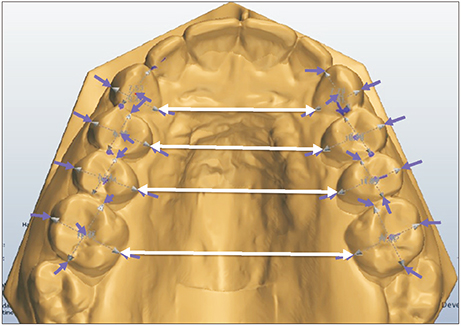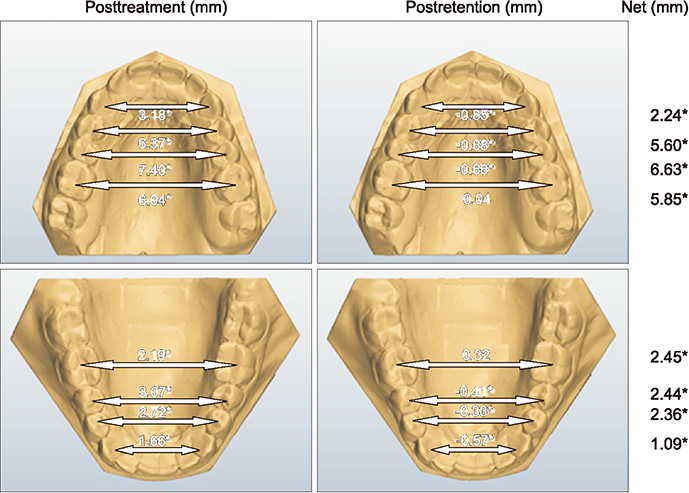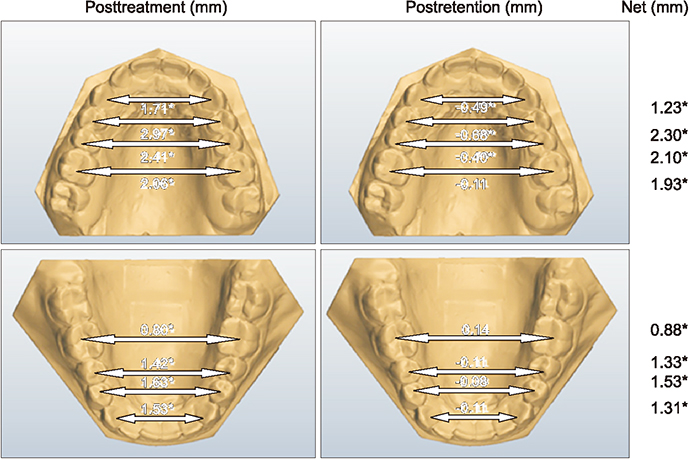Korean J Orthod.
2019 Mar;49(2):89-96. 10.4041/kjod.2019.49.2.89.
Long-term stability of maxillary and mandibular arch dimensions when using rapid palatal expansion and edgewise mechanotherapy in growing patients
- Affiliations
-
- 1Department of Orthodontics, Saint Louis University, St. Louis, MO, USA. kkim8@slu.edu
- 2Private Practice, Columbia, IL, USA.
- 3Private Practice, Florianopolis, SC, Brazil.
- KMID: 2453972
- DOI: http://doi.org/10.4041/kjod.2019.49.2.89
Abstract
OBJECTIVE
The purpose of this study was to assess the long-term stability of rapid palatal expansion (RPE) followed by full fixed edgewise appliances.
METHODS
This study included 67 patients treated using Haas-type RPE and non-extraction edgewise appliance therapy at a single orthodontic practice. Serial dental casts were obtained at three different time points: pretreatment (T1), after expansion and fixed appliance therapy (T2), and at long-term recall (T3). The mean duration of the T1-T2 and T2-T3 periods was 4.8 ± 3.5 years and 11.0 ± 5.4 years, respectively. The dental casts were digitized, and the computed measurements were compared with untreated reference data.
RESULTS
The majority of treatment-related increases in the maxillary and mandibular arch measurements were statistically significant (p < 0.05) and greater than expected for the untreated controls. Although many measurements decreased postretention (T2-T3), the net gains persisted for all of the measurements evaluated.
CONCLUSIONS
The use of RPE therapy followed by full fixed edgewise appliances is an effective method for increasing maxillary and mandibular arch width dimensions in growing patients.
Keyword
Figure
Cited by 1 articles
-
Reader's Forum
Seung-Youp Lee
Korean J Orthod. 2019;49(4):203-204. doi: 10.4041/kjod.2019.49.4.203.
Reference
-
1. Timms DJ. The dawn of rapid maxillary expansion. Angle Orthod. 1999; 69:247–250.2. Haas AJ. The treatment of maxillary deficiency by opening the midpalatal suture. Angle Orthod. 1965; 35:200–217.3. Moussa R, O'Reilly MT, Close JM. Long-term stability of rapid palatal expander treatment and edgewise mechanotherapy. Am J Orthod Dentofacial Orthop. 1995; 108:478–488.
Article4. Wertz RA. Skeletal and dental changes accompanying rapid midpalatal suture opening. Am J Orthod. 1970; 58:41–66.
Article5. Asanza S, Cisneros GJ, Nieberg LG. Comparison of Hyrax and bonded expansion appliances. Angle Orthod. 1997; 67:15–22.6. McNamara JA Jr, Baccetti T, Franchi L, Herberger TA. Rapid maxillary expansion followed by fixed appliances: a long-term evaluation of changes in arch dimensions. Angle Orthod. 2003; 73:344–353.7. Barry M. In-office digital study models. J Clin Orthod. 2011; 45:385–389.8. Moyers RE, vander Linden FP, Riolo ML, McNamara JA. Standards of human occlusal development. Monograph 5. Craniofacial growth series. Ann Arbor: Center for Human Growth and Development, University of Michigan;1976. p. 371.9. Haahr M. True random number service [Internet]. Dublin: RANDOM.ORG;1998. cited 2014 May 4. Available from: www.random.org.2010.10. Haas AJ. Palatal expansion: just the beginning of dentofacial orthopedics. Am J Orthod. 1970; 57:219–255.
Article11. Lima AC, Lima AL, Filho RM, Oyen OJ. Spontaneous mandibular arch response after rapid palatal expansion: a long-term study on Class I malocclusion. Am J Orthod Dentofacial Orthop. 2004; 126:576–582.
Article12. Pinheiro FH, Garib DG, Janson G, Bombonatti R, de Freitas MR. Longitudinal stability of rapid and slow maxillary expansion. Dental Press J Orthod. 2014; 19:70–77.
Article13. Mohan CN, Araujo EA, Oliver DR, Kim KB. Long-term stability of rapid palatal expansion in the mixed dentition vs the permanent dentition. Am J Orthod Dentofacial Orthop. 2016; 149:856–862.
Article
- Full Text Links
- Actions
-
Cited
- CITED
-
- Close
- Share
- Similar articles
-
- A posteroanterior cephalometric study on the change of maxilla by rapid palatal expansion
- Crowding with no posterior crossbite treatment byrapid palatal expansion
- A study on the effect of rapid maxillary expansion and its relapse
- Surgically assisted rapid maxillary expansion and orthognathic treatments: report of 2 cases
- Three-dimensional assessment of the temporomandibular joint and mandibular dimensions after early correction of the maxillary arch form in patients with Class II division 1 or division 2 malocclusion






